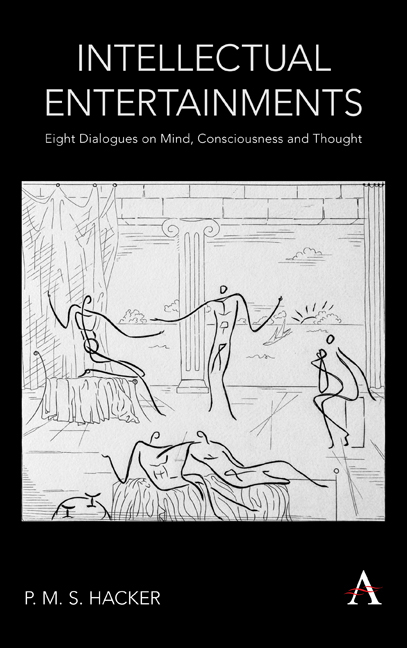Book contents
- Frontmatter
- Dedication
- Contents
- Preface
- Acknowledgements
- Section 1 Two Dialogues on Mind and Body
- Section 2 Two Dialogues on Consciousness
- Section 3 A Dialogue on the Objectivity or Subjectivity of Perceptual Qualities
- Section 4 Two Dialogues on Thought
- Introduction
- Sixth Dialogue Thought
- Seventh Dialogue Thought and Language
- Section 5 A Dialogue on Ownership of Pain
Introduction
from Section 4 - Two Dialogues on Thought
Published online by Cambridge University Press: 06 December 2019
- Frontmatter
- Dedication
- Contents
- Preface
- Acknowledgements
- Section 1 Two Dialogues on Mind and Body
- Section 2 Two Dialogues on Consciousness
- Section 3 A Dialogue on the Objectivity or Subjectivity of Perceptual Qualities
- Section 4 Two Dialogues on Thought
- Introduction
- Sixth Dialogue Thought
- Seventh Dialogue Thought and Language
- Section 5 A Dialogue on Ownership of Pain
Summary
There can be few thinking people who have not, at some time or other, wondered about the nature of thought. Thought seems to be able to do so many remarkable things. Sitting at home, one can think of someone on the other side of the world, and one's thought, it seems, unerringly reaches right out to him. It transfixes him, as it were, with an unerring mental arrow – this → is the person of whom I am thinking, and no other. How can this be? Indeed one can think of people who no longer exist, of Solon or Socrates. How does one's thought reach back into the depths of the past to pinpoint just Solon and not Solomon, or just Socrates and not Hippocrates? Moreover, can one not think of personages who never existed, such as Adam and Eve, Zeus or Aphrodite? How is this magic effected?
Equally baffling – once one thinks of it – is the sheer speed of thought. Faced with an urgent practical predicament, one often comes to a conclusion like greased lightning, although after the event it may take one ten minutes to explain the reasons why one decided to do what one did. One may see the solution to a theoretical problem in a flash, but showing it to be the solution may take one half an hour. The great Cambridge mathematician G. H. Hardy, in the course of a lecture, is said to have written an equation on the blackboard and to have remarked casually: ‘That's self-evident’. A student in the front row exclaimed, ‘It doesn't seem self-evident to me, Professor Hardy’. Hardy picked up a piece of chalk and started writing formulae on the blackboard. Half an hour later, having covered three blackboards with figures, he underlined the final line of the proof and turned triumphantly to the student exclaiming ‘I told you it was self-evident!’ How can this be? How can one think one's way to the solution of a complex proof in a flash, when it takes half an hour to spell out what one thought? Thought is indeed a mysterious process.
- Type
- Chapter
- Information
- Intellectual EntertainmentsEight Dialogues on Mind, Consciousness and Thought, pp. 145 - 148Publisher: Anthem PressPrint publication year: 2019



